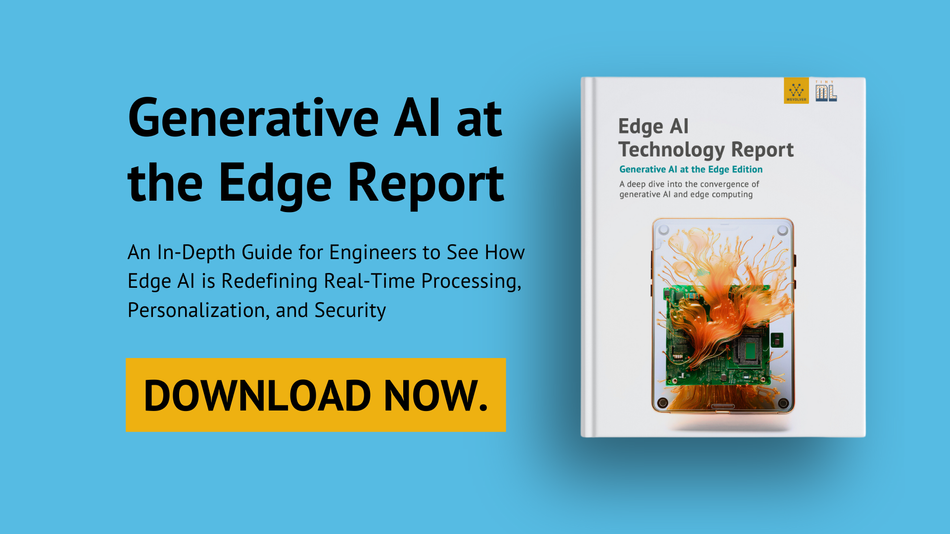Edge AI Technology Report: Generative AI Edition
A deep dive into the convergence of generative AI and edge computing.

We once believed the cloud was the final frontier for artificial intelligence (AI), but it turns out the real magic happens much closer to home—at the edge, where devices can now think, generate, and respond in real-time. The rapid evolution of AI, particularly generative AI, is fundamentally reshaping industries and challenging the existing computing infrastructure.
Traditional models, especially resource-intensive ones like Large Language Models (LLMs), have long relied on centralized cloud systems for the necessary computational power. However, as the need for AI-driven interactions grows across sectors—from autonomous vehicles to personalized content generation—there is a clear shift toward edge computing.
Our new report, drawing from discussions with industry leaders and technologists, explores how generative AI is being harnessed and integrated into edge environments and what this means for the future of technology.
Download your copy today to stay ahead of generative AI at the edge.
<Form>
Why this report matters?
Learning about GenAI at the edge is crucial for engineers to meet growing industry demands and stay competitive in a rapidly evolving field. As industries like autonomous vehicles, healthcare, IoT, and industrial automation increasingly rely on real-time AI solutions, engineers must adapt their skills to handle resource-constrained environments and optimize AI models for efficient edge computing. Understanding how to deploy GenAI at the edge allows engineers to develop faster, more secure systems, addressing key industry challenges such as low-latency performance, privacy, and data security.
Staying ahead in this complex field requires mastering techniques like model optimization, federated learning, and energy-efficient processing. By learning about GenAI at the edge, engineers enhance their expertise in interdisciplinary areas such as machine learning, embedded systems, and networking, positioning themselves at the forefront of technological advancements. This knowledge not only boosts career prospects but also ensures engineers can innovate solutions for future technologies like 5G, IoT, and intelligent systems.
Report Highlights:
- Cutting-Edge Applications: Real-world examples show how generative AI at the edge is revolutionizing operations in fields like autonomous driving, medical diagnostics, industrial automation, and retail.
- Optimization Techniques for Edge Deployment: Insights on deploying complex AI models on resource-limited devices using techniques such as pruning, quantization, and federated learning.
- Industry Perspectives: Contributions from EmbedUR, Ambiq, and BrainChip offer expert guidance on how generative AI is reshaping sectors requiring real-time data processing and intelligent responses.
- Challenges and Solutions: Analysis of key challenges faced when deploying AI at the edge and practical solutions, including orchestration frameworks, MLOps, and secure data protocols.
Download the full report with custom illustrations and case studies below:
<Form>
Report introduction
Unlike cloud-centric approaches, edge computing brings data processing closer to where it is generated—on devices such as sensors, microcontrollers (MCUs), gateways, and more powerful edge servers. This shift is essential for applications requiring low latency, high bandwidth efficiency, and enhanced data privacy. The first chapter of this report dives into the foundational role that edge computing plays in enhancing generative AI, providing a detailed look at the various devices involved and the practical considerations for integrating these technologies. The chapter also explores how orchestration and machine learning operations (MLOps) are critical in managing AI workloads across the edge-to-cloud continuum, with insights from industry perspectives on the benefits and challenges of edge deployments.
As we move through the report, we delve into the innovations and advancements driving this convergence. The second chapter highlights recent breakthroughs in generative AI and edge research, examining how AI workloads are coordinated from the far edge to the cloud. This chapter not only covers the technical advancements but also provides a market analysis of the trends and drivers behind industry adoption. The focus is on understanding the collaborative efforts and partnerships pushing the boundaries of what is possible in this space.
Real-world applications bring these concepts to life, so we dedicated the third chapter to showcasing use cases for deploying generative AI at the edge across various industries. The report illustrates how these technologies transform operations in robotics, healthcare, manufacturing, automotive, retail, and smart cities. These examples highlight the tangible benefits of deploying AI at the edge, including improved efficiency, real-time decision-making, and enhanced user experiences.
Of course, with innovation comes challenges. The fourth chapter addresses the key hurdles organizations face when implementing generative AI at the edge, from managing the complexity of distributed networks to ensuring the reliability of AI models in resource-constrained environments. This section offers strategies and best practices for overcoming these challenges, informed by insights from leading experts in the field.
Finally, the report considers the broader impact of these technologies on business and society. The fifth chapter discusses the economic, social, and environmental implications of deploying generative AI at the edge. It explores how these technologies can drive cost savings, enhance accessibility, and contribute to sustainability goals, with perspectives from industry leaders on the long-term effects.
This report reflects the authors’, contributors’, and Wevolver’s deep commitment to providing industry leaders, technologists, and decision-makers with the insights needed to navigate the complex landscape of generative AI and edge computing. The contributions from the Wevolver team, along with extensive research and expert input, ensure that the content not only informs but also inspires further innovation. As you engage with this report, we hope it serves as a comprehensive guide to understanding and harnessing the power of generative AI at the edge, offering a roadmap for future advancements and industry growth.
Download the full report now.
<form>
Acknowledgments
This report is made possible by the support of our sponsors, EmbedUR, Ambiq, and BrainChip.
Samir Jaber was the editor-in-chief and provided incredible leadership and expertise. We encourage you to share this report with your colleagues and network.
